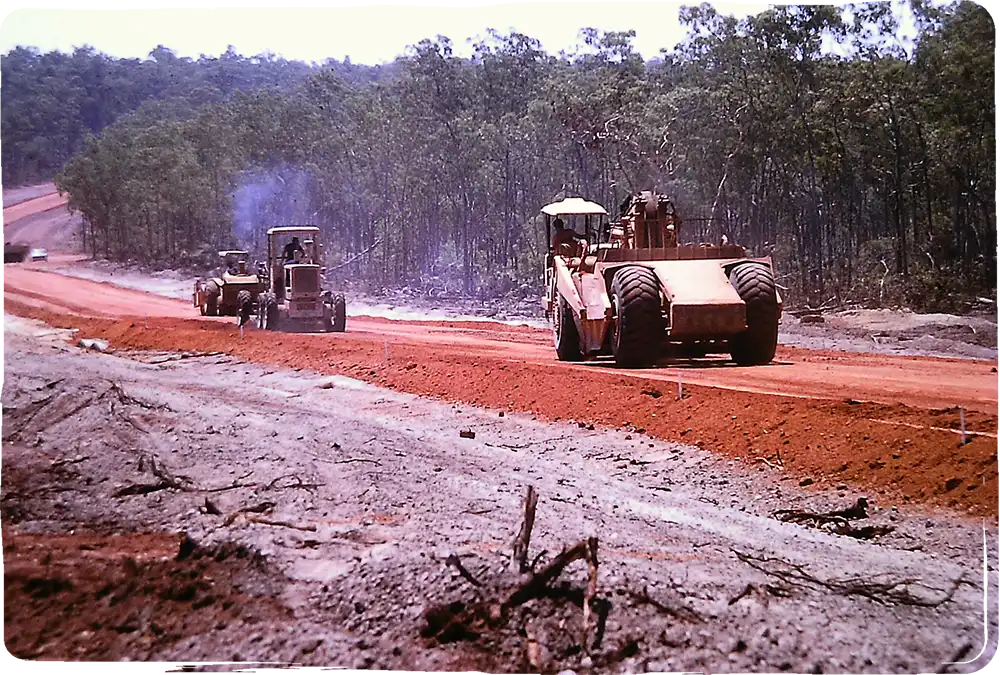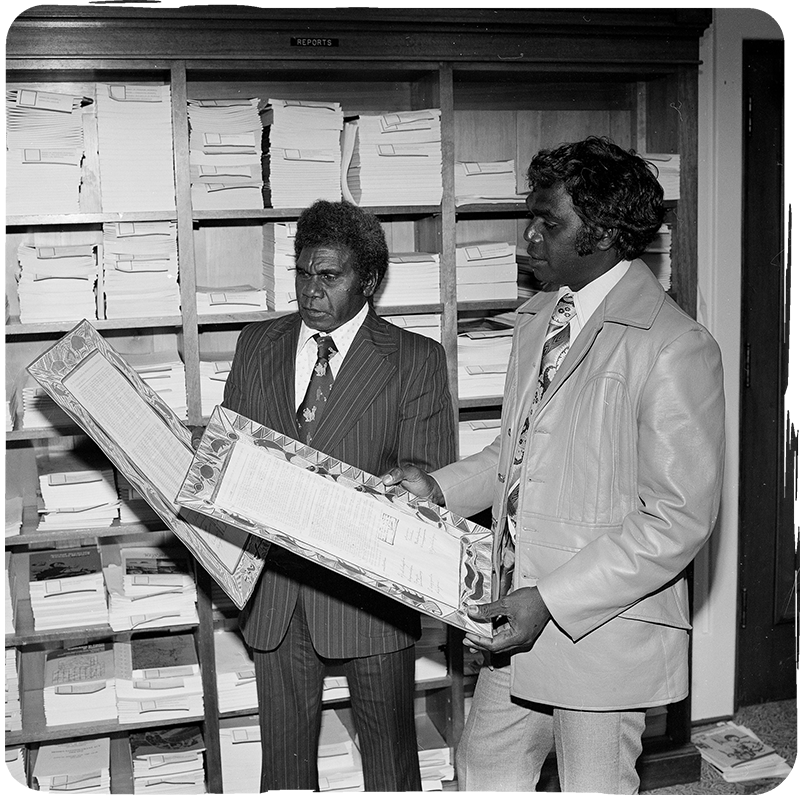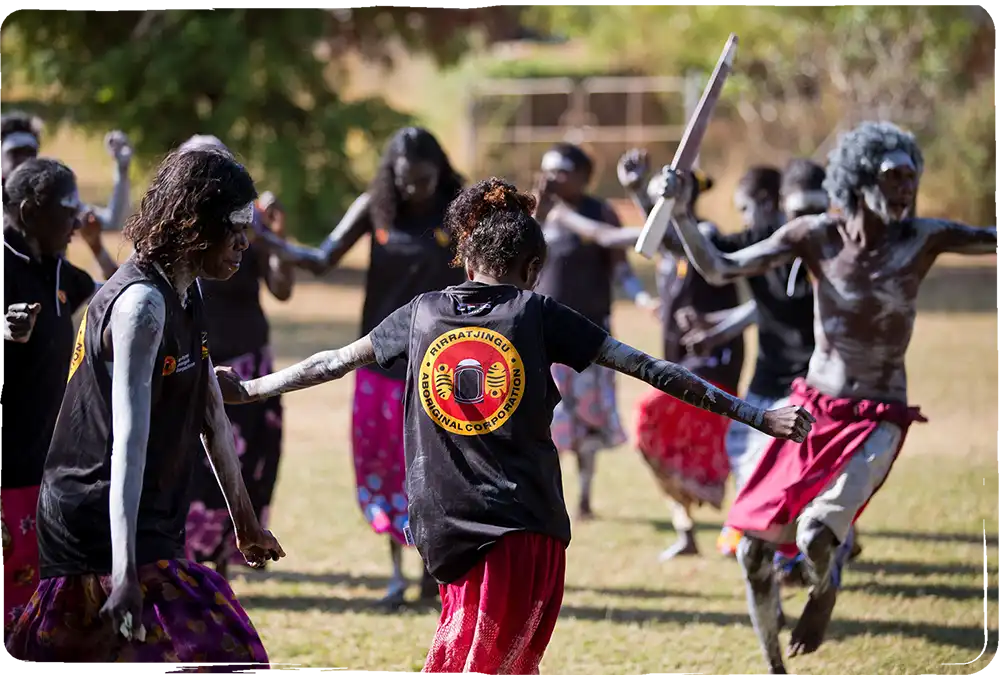
Our history
Indigenous Traditional Owners of the Gove Peninsula
The Birth of a People
The Djang’kawu narrative, referred to by some as the Dreamtime story, tells of how the Rirratjingu Clan was formed.
It begins with the Djang’kawu brother and his two sisters, Bitjiwurrurru and Madalatj, who journeyed from Burralku through the darkness with only the Morning Star to guide them. When they reached the shores of Yalangbara, the sun rose to herald the birth of the world.
The sisters were the owners of ceremonial lore and travelled with their digging sticks (mawalan or djota), feathered regalia and sacred objects (rangga) in their conical baskets and mats (nganmarra). These seemingly ordinary objects transformed into different landforms along the way. The feathered string became sand ridges, the mat became an island and the clap sticks (bilma) became rocky outcrops.
The pregnant Bitjiwurrurru gave birth to the Rirratjingu Clan and bestowed on them their language and ownership of the land. The first Ngarra ceremony was performed in a manner that is still performed to this day. It demonstrates the unbreakable link that the Rirratjingu have to their land, their culture and their history.
There is no timeframe to the Djang’kawu narrative, but anthropologists say that the Rirratjingu people have lived in North-East Arnhem Land for about 55,000 years. This would makes them the oldest continuous culture in the world.
The Rirratjingu clan is one of 13 clan groups within the Gove Peninsula. Many of those clan groups belong to the Yolŋu people of Miwatj (which translates to ‘land of the first sunrise’ in Yolŋu tongue, i.e. North East Arnhem Land).

First Contact with Outsiders
Before Europeans arrived, the Yolŋu’s first significant contact with outsiders was with the Macassan fishers who traveled to northern Australia from the 18th century in search of trepang.
To this day, the Rirratjingu recount the story of an encounter between the Macassans and the Djang’kawu ancestors on the island of Wapilina. Wapilina was the largest Macassan trepang processing camp in Northern Australia. Rirratjingu artists often paint scenes from this encounter.Europeans arrived in the late 19th century and a mission settlement was established at Yirrkala in the early 20th century. The contact between Macassans and the Yolŋu ended when the Australian Government banned the trepang trade in 1907.
The Day the Mine Arrived
The most significant outside influence to the region started in the 1960s when bauxite mining began on the Gove Peninsula. The Rirratjingu and other clans sent bark petitions to the Federal Parliament, opposing the mining and asserting their rights to traditional lands.

The protests did not stop the mining. However, a parliamentary inquiry recommended compensation for the Yolŋu people. It also called for the protection of their sacred sites. This led to the foundation of Aboriginal Land Rights in Australia through the Land Rights Act of 1976.
RAC was established in 1984 to manage mining royalties for the Rirratjingu clan. RAC’s goal is to improve living standards, create equal opportunities, and support sustainable business and economic independence.
The Yirrkala Bark Petitions

The Yirrkala Bark Petitions are a series of four petitions created by the Yolŋu people in the early 1960’s. They showcase a key moment in our journey for recognition and land rights, and are a key part of Rirratjingu and our nation’s history.
The Petitions sit among Australia’s landmark constitutional documents, as they bridge Commonwealth law with Indigenous law. They embody the inspiration of our past leaders, who laid the groundwork for our success today.

Life Today
The Rirratjingu kinship system governs many aspects of our lives today, including ceremony responsibilities, gender relationships and marriage rules.

Our Rirratjingu family work to ensure our Yolŋu culture and land are protected. We are proud of our forefathers and their tireless efforts to seek recognition of Aboriginal land rights in Australia.
Today, RAC’s purpose is to represent the Rirratjingu people and manage funds from mining and business investments for their benefit, both now and in the future.
2024 marked 40 years since Rirratjingu Aboriginal Corporation was founded by our late father, Dadyngfa Roy Marika (MBE). The Corporation was established to manage the affairs of our people, particularly as they relate to our lands and mining royalties associated with the use of our lands. Over the past forty years, RAC has carried a huge responsibility for our people. Not just yesterday and today, but a responsibility for the many generations to come.

“As we celebrate 40 years in the life of the Rirratjingu Aboriginal Corporation, we do so with an enormous sense of pride and satisfaction.
To stand here today, in the knowledge of what we have achieved, and to share this moment with you all on behalf of our members, directors and staff, is very satisfying.
To also do it on behalf of all those that have established the foundation upon which we have built, our forefathers, is very special.
It is with thanks to the energy and resolve of these people that we celebrate this milestone. Without their vision we would not be where we are today.
We look forward to a future where we can continue to meet the needs of our people.
We look forward to a future where we can continue to play a leadership role across the region in matters of social and economic prosperity for the benefit of our entire community.” – Wanybui Marika – Chairman, RAC.

Connect with Us
If you’re interested in learning more about Rirratjingu Aboriginal Corporation and our history, we’d love to hear from you.

